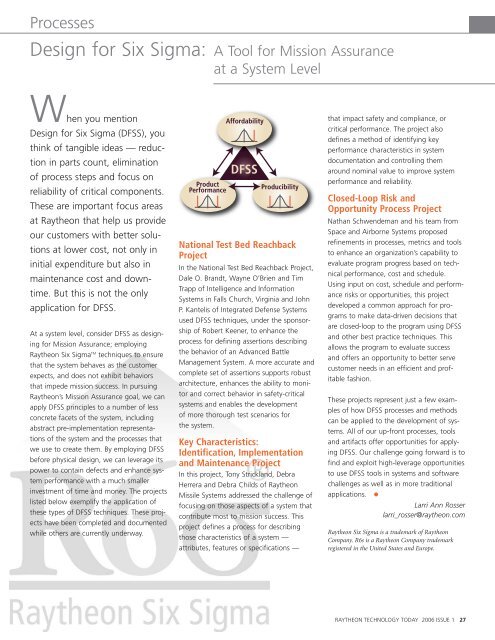ACHIEVING MISSION ASSURANCE - Raytheon
ACHIEVING MISSION ASSURANCE - Raytheon
ACHIEVING MISSION ASSURANCE - Raytheon
Create successful ePaper yourself
Turn your PDF publications into a flip-book with our unique Google optimized e-Paper software.
Processes<br />
Design for Six Sigma: A Tool for Mission Assurance<br />
at a System Level<br />
When you mention<br />
Design for Six Sigma (DFSS), you<br />
think of tangible ideas — reduction<br />
in parts count, elimination<br />
of process steps and focus on<br />
reliability of critical components.<br />
These are important focus areas<br />
at <strong>Raytheon</strong> that help us provide<br />
our customers with better solutions<br />
at lower cost, not only in<br />
initial expenditure but also in<br />
maintenance cost and downtime.<br />
But this is not the only<br />
application for DFSS.<br />
At a system level, consider DFSS as designing<br />
for Mission Assurance; employing<br />
<strong>Raytheon</strong> Six Sigma TM techniques to ensure<br />
that the system behaves as the customer<br />
expects, and does not exhibit behaviors<br />
that impede mission success. In pursuing<br />
<strong>Raytheon</strong>’s Mission Assurance goal, we can<br />
apply DFSS principles to a number of less<br />
concrete facets of the system, including<br />
abstract pre-implementation representations<br />
of the system and the processes that<br />
we use to create them. By employing DFSS<br />
before physical design, we can leverage its<br />
power to contain defects and enhance system<br />
performance with a much smaller<br />
investment of time and money. The projects<br />
listed below exemplify the application of<br />
these types of DFSS techniques. These projects<br />
have been completed and documented<br />
while others are currently underway.<br />
National Test Bed Reachback<br />
Project<br />
In the National Test Bed Reachback Project,<br />
Dale O. Brandt, Wayne O’Brien and Tim<br />
Trapp of Intelligence and Information<br />
Systems in Falls Church, Virginia and John<br />
P. Kantelis of Integrated Defense Systems<br />
used DFSS techniques, under the sponsorship<br />
of Robert Keener, to enhance the<br />
process for defining assertions describing<br />
the behavior of an Advanced Battle<br />
Management System. A more accurate and<br />
complete set of assertions supports robust<br />
architecture, enhances the ability to monitor<br />
and correct behavior in safety-critical<br />
systems and enables the development<br />
of more thorough test scenarios for<br />
the system.<br />
Key Characteristics:<br />
Identification, Implementation<br />
and Maintenance Project<br />
In this project, Tony Strickland, Debra<br />
Herrera and Debra Childs of <strong>Raytheon</strong><br />
Missile Systems addressed the challenge of<br />
focusing on those aspects of a system that<br />
contribute most to mission success. This<br />
project defines a process for describing<br />
those characteristics of a system —<br />
attributes, features or specifications —<br />
that impact safety and compliance, or<br />
critical performance. The project also<br />
defines a method of identifying key<br />
performance characteristics in system<br />
documentation and controlling them<br />
around nominal value to improve system<br />
performance and reliability.<br />
Closed-Loop Risk and<br />
Opportunity Process Project<br />
Nathan Schwendeman and his team from<br />
Space and Airborne Systems proposed<br />
refinements in processes, metrics and tools<br />
to enhance an organization’s capability to<br />
evaluate program progress based on technical<br />
performance, cost and schedule.<br />
Using input on cost, schedule and performance<br />
risks or opportunities, this project<br />
developed a common approach for programs<br />
to make data-driven decisions that<br />
are closed-loop to the program using DFSS<br />
and other best practice techniques. This<br />
allows the program to evaluate success<br />
and offers an opportunity to better serve<br />
customer needs in an efficient and profitable<br />
fashion.<br />
These projects represent just a few examples<br />
of how DFSS processes and methods<br />
can be applied to the development of systems.<br />
All of our up-front processes, tools<br />
and artifacts offer opportunities for applying<br />
DFSS. Our challenge going forward is to<br />
find and exploit high-leverage opportunities<br />
to use DFSS tools in systems and software<br />
challenges as well as in more traditional<br />
applications.<br />
Larri Ann Rosser<br />
larri_rosser@raytheon.com<br />
<strong>Raytheon</strong> Six Sigma is a trademark of <strong>Raytheon</strong><br />
Company. R6s is a <strong>Raytheon</strong> Company trademark<br />
registered in the United States and Europe.<br />
RAYTHEON TECHNOLOGY TODAY 2006 ISSUE 1 27

















